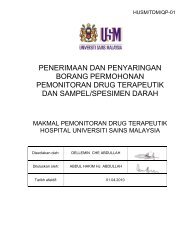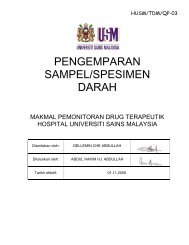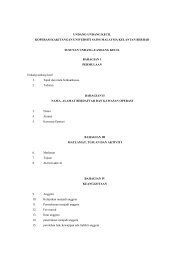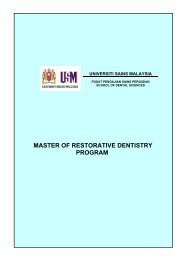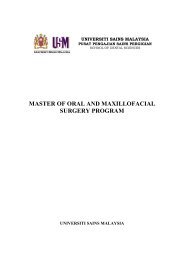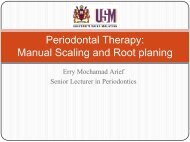Vol 11-R2- Eyelid
Vol 11-R2- Eyelid
Vol 11-R2- Eyelid
Create successful ePaper yourself
Turn your PDF publications into a flip-book with our unique Google optimized e-Paper software.
SRPS • <strong>Vol</strong>ume <strong>11</strong> • Issue <strong>R2</strong> • 2010<br />
supratrochlear, infratrochlear, and medial<br />
palpebral vessels (Fig. 22). Its attachment to the<br />
medial fat pad is kept intact, and the area acts as<br />
its pedicle, allowing rotation of the flap to cover a<br />
variety of different medial defects. As described by<br />
Jelks et al., the flap is sutured in place in layered<br />
fashion with deep 5-0 Vicryl sutures and 6-0 nylon<br />
sutures to approximate the skin. The donor site is<br />
closed primarily. 143,144<br />
Skin Grafts<br />
Full-thickness skin grafts are useful for correcting<br />
medial canthal defects that are relatively superficial.<br />
The skin can be harvested from the upper eyelid,<br />
retroauricular, supraclavicular, and inner arm<br />
areas. 22,41,42 Dryden and Wulc 145 described using<br />
preauricular skin, which can provide a better color<br />
match, as opposed to the traditional retroauricular<br />
grafts. Although grafts are very useful, skin<br />
color and thickness match can be cosmetically<br />
challenging. Nevertheless, skin grafts are commonly<br />
used to cover medial canthal defects. They are<br />
simple, effective, and conform well to the concave<br />
surface of the medial canthus. They should be<br />
avoided when vascular compromise of the recipient<br />
bed is suspected, such as in smokers or after<br />
radiation damage.<br />
Bipalpebral Sliding Flaps<br />
Adenis and Serra 146 described a technique that uses<br />
a combination of flaps from the upper and lower<br />
eyelids to correct medial canthal defects. Upper<br />
eyelid incisions are made 2 mm above the cilia<br />
and 2 mm below the brow. The lower lid incisions<br />
are made 2 mm below the cilia, and the inferior<br />
incision is created in a curvilinear fashion starting<br />
at the lower edge of the defect and continuing<br />
to the inner portion of the cheek (approximately<br />
10−20 mm below the superior incision). The flaps<br />
are undermined at the level of the orbicularis<br />
muscle and are slid into place, covering the medial<br />
defect. With a small defect, the two flaps can be<br />
approximated to each other, completely covering<br />
the defect. With larger defects, the individual flaps<br />
can be tacked down to the underlying tissue and<br />
36<br />
a full thickness skin graft can be used to cover the<br />
remaining area. Because this is a sliding cutaneous<br />
flap, it is not useful in cases of deep medial<br />
canthal defects. 146<br />
Medial Pedicled Orbicularis Oculi Flap<br />
The medial pedicled orbicularis oculi flap, as<br />
described by Tezel et al. 144 in 2002, combines<br />
concepts from the bipalpebral sliding flap and<br />
the myocutaneous flap. The lower edge of the flap<br />
is the lid crease. The width of the flap created<br />
depends on the size of the defect. The flap is then<br />
elevated lateral to medial and includes both skin<br />
and orbicularis. The medial portion of the flap is<br />
de-epithelialized, and the flap is tunneled to the<br />
contralateral side, allowing the de-epithelialized<br />
portion of the flap to be buried under the tunnel<br />
while the myocutaneous flap is inset to the area of<br />
the defect. The flap is sutured in place in a layered<br />
fashion, and the donor site is closed primarily<br />
(Fig. 23). 144,147<br />
Mid Forehead Flaps<br />
Mid forehead flaps, including the median and<br />
paramedian flaps and their many variations, are<br />
useful in midfacial reconstruction, including<br />
reconstruction of medial canthal defects. Forehead<br />
skin flaps are consistently useful for reconstruction<br />
of the periorbital region in that they have a rich<br />
network of vascular structure and low donor site<br />
morbidity, are thin and pliable, and are compatible<br />
with the color of the facial skin. 148 Per Baker, 139<br />
the median forehead flap was originally described<br />
in the Indian medical treatise in approximately<br />
700 bce and has evolved greatly over time. Baker<br />
reported that in the 1930s, Kazanjian described<br />
the procedure in detail. The technique presented<br />
by Kazanjian used a midline forehead flap that was<br />
created with a hairline incision that continued to a<br />
point immediately above the nasofrontal angle and<br />
derived its blood supply from the supratrochlear<br />
and supraorbital arteries. In the 1960s, Millard 149<br />
described a modification of the median forehead<br />
flap called the seagull flap with which lateral<br />
extensions were used to cover the nasal alae. The



